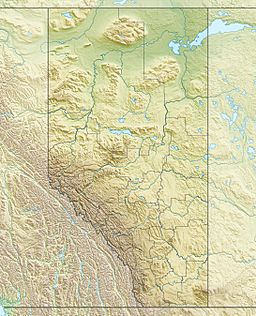Christina Lake (Alberta) facts for kids
Quick facts for kids Christina Lake |
|
|---|---|
| Location | Wood Buffalo, Alberta |
| Coordinates | 55°37′21″N 110°52′42″W / 55.62250°N 110.87833°W |
| Primary inflows | Sunday Creek, Birch Creek |
| Primary outflows | Jackfish River |
| Catchment area | 1,250 square kilometres (480 sq mi) |
| Basin countries | Canada |
| Max. length | 18 km (11 mi) |
| Max. width | 2 km (1.2 mi) |
| Surface area | 21.3 km2 (8.2 sq mi) |
| Average depth | 17.3 m (57 ft) |
| Max. depth | 32.9 m (108 ft) |
| Surface elevation | 556 m (1,824 ft) |
Christina Lake is a long, narrow lake in northern Alberta, Canada. You can find it near Highway 881, east of Conklin. It sits between the towns of Lac La Biche and Fort McMurray. Both Christina Lake and the Christina River are named after Christine Gordon. She was the first white woman to live permanently in the Fort McMurray area.
Contents
About Christina Lake's Water
Christina Lake is located at an elevation of 556 m (1,824 ft) above sea level. The lake covers a total area of about 21.3 km2 (8.2 sq mi). Its average depth is 17.3 m (57 ft), and its deepest point reaches 32.9 m (108 ft).
How Water Flows Through the Lake
The lake gets its water from six streams that flow into it all year round. The main outlet is the Jackfish River, located at the western end of the lake. The Jackfish River flows for about 11 kilometres (6.8 mi) before joining the Christina River. The Christina River then flows into the Clearwater River. Eventually, all this water makes its way to the Arctic Ocean through the Athabasca and MacKenzie River systems.
The Story Behind Christina Lake's Name
Christina Lake and the Christina River are named in honour of Christine Gordon. She came from Scotland and was the first white woman to live permanently in the Fort McMurray area. She stayed there until she passed away in the 1940s.
Christine Gordon's Impact on the Community
Christine Gordon was highly respected by everyone in the community. This included the First Nations and Métis people. She was known for her ability to treat illnesses and injuries. She learned a lot from a Scottish home nursing book. She could set a broken arm, lower a fever, and even mix herbal medicines. By 1914, she owned and ran her own trading post in Fort McMurray. This was quite a feat, as she was competing with the well-known Hudson's Bay Company.
Conklin's Move and the Fur Trade
The small town of Conklin was first located at the very northwest end of Christina Lake. It was right next to where the Jackfish River flows out. In 1921, when the Alberta and Great Waterways Railway reached Conklin, the town moved. It was relocated to be closer to the railway tracks.
From 1940 to 1960, Christina Lake was an important place for the local fur trade. There were several mink farms in the area. Mink pelts were transported by canoe and dogsled to the railway siding. From there, they were shipped to markets. During this time, there was also a lot of commercial fishing on Christina Lake. A fish processing plant was set up at the outlet to the Jackfish River.
Forest Fires Around the Lake
The Lac la Biche Forest surrounds parts of Christina Lake. This area often experiences more lightning storms than average. This means there's a higher chance of forest fires starting naturally.
Managing Resources Around Christina Lake
Timber Resources
Around Christina Lake, you can find small groups of trees. These include evergreen trees (conifers), mixed forests, and areas with only aspen trees. However, most of these trees are not suitable for commercial logging.
Energy Resources in the Area
Christina Lake is located within the Athabasca Oil Sands region. This area is rich in a thick, sticky form of oil called bitumen. Since 2000, a company called Cenovus Energy has been operating its Christina Lake project here.
How Oil is Recovered
The Christina Lake project uses a method called steam-assisted gravity drainage, or SAGD. This process helps to recover bitumen from the McMurray Formation. This rock layer is found about 375 m (1,230 ft) deep in the ground at this location. Cenovus Energy considers this project very important. They see it as one of their best oil sands projects with a lot of potential for future growth. Besides bitumen, the area also has natural gas reserves. These gas reserves were already being extracted as early as 1991.


